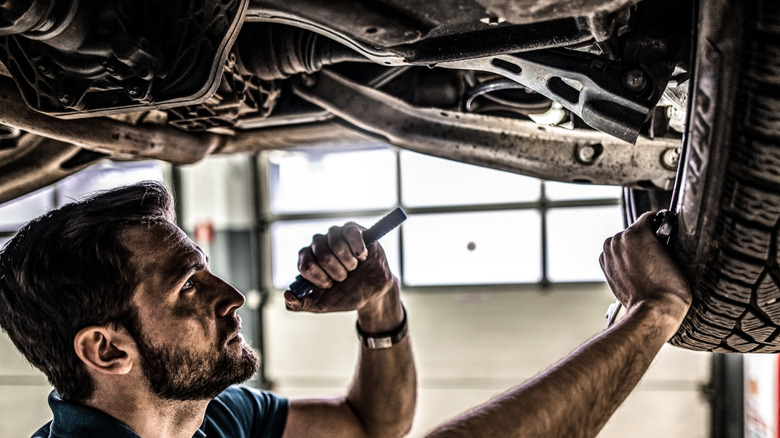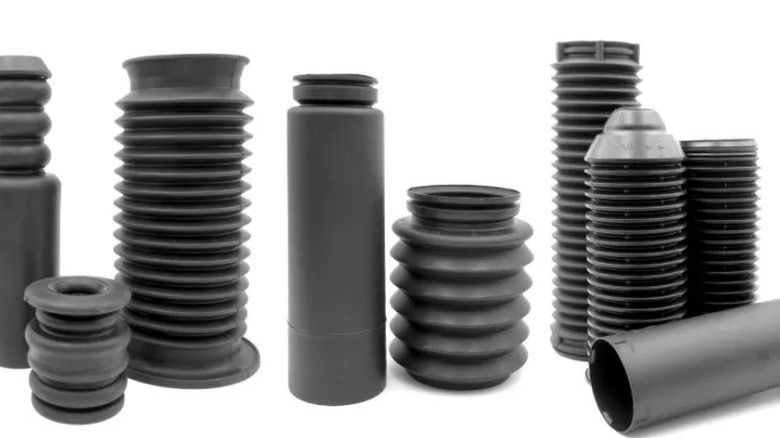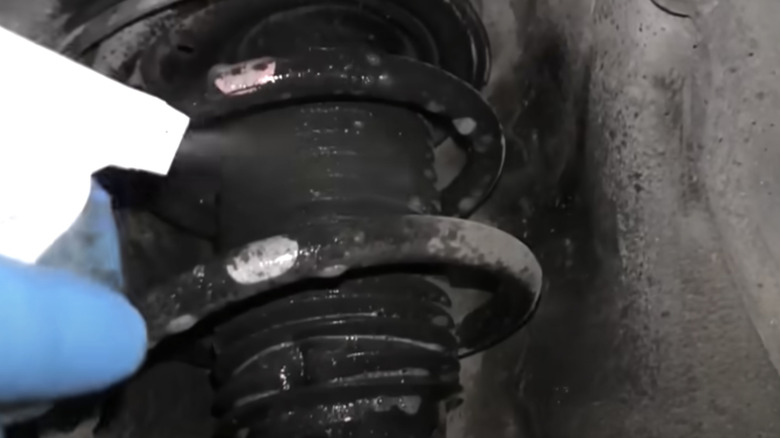Can You Use A Sealant To Help Your Car's Suspension Last Longer?
Your car's suspension is protected by rubber components, with boots, bushings, mounts, bump stops, grommets, and seals working together to protect its moving parts against dirt, grime, weather, water, friction, and wear. Over time, these rubberized bits and pieces perish and break down as oxidation, UV damage, chemical attack, and mechanical wear take their cumulative toll.
Surprisingly, this process of deterioration can be dramatically slowed by applying a product we would normally associate with fixing engine oil leaks. Bearing in mind if the rubber part is cracked, torn, vulcanized, or severely hardened, no magic sponge is going to fix it. If you're at this late stage, where the rubber has met its demise, you must replace it — and also check the component it was designed to protect.
Where a rubber-reviving, stop-leak product such as ATP Automotive's TP-205 comes into its own is not as a fix-it kit, but as part of your vehicle's ongoing preventative maintenance schedule. However, it is important we check we have the right product for the job. For example, WD-40 can wreak havoc on rubber seals that it's not designed for. Or to put it another way, you wouldn't wipe engine stop-leak on faded and cracked tire sidewalls, nor should you use black tire dressing to restore rubber suspension parts.
Use the right protectant for the job
The rubber in a car tire is radically different in both composition and properties to the rubber in a water-resisting car door seal, which is in turn different to an engine oil seal. However, the rubber in a suspension seal has much more in common with an engine seal. Both are chemical and oil-resistant, flexible, moderately hard-wearing, and of similar composition — usually NBR, a nitrile rubber-neoprene compound.
Experienced mechanics have found TP-205 works not only on engine seals, but on car suspensions seals, too. As the manufacturer points out, it contains the same plasticizers used in making such seals. While automotive additive manufacturers are notoriously coy about their secret sauces — for example, Blue Devil says the ingredients of its Oil Stop Leak "are being withheld as a trade secret" — ATP is less circumspect, and lists 100% of its ingredients as glycol ethers.
Because NBR rubber is not resistant to them, glycol ethers cause these rubber seals to soften and swell, which explains, in part, how the resealing and reviving effect works. Interestingly, backyard mechanics have long used brake fluid — also a glycol ether — to rejuvenate perished rubber. Which is not to say we recommend this hack: When dealing with suspension parts, use the product designed for the job, and follow the instructions. TP-205 is designed specifically for engine, transmission, power steering, differential, and hydraulic systems — excluding brakes, but including suspensions.
Just spray it on, and everything is swell
While the chemistry may sound complicated, the application is easy. To make it even easier, you can tip the product into a handy spray bottle, which is how Scotty Kilmer does it in his instructional video. The types of rubber suspension seals you are looking to reseal and maintain include CV boots, shock mounts, shock seals, ball joints, power steering boots, even motorcycle fork seals — it's easier to find them than to exhaustively list them.
The best way to find these little grommets is to use a jack and axle stands, lift each wheel of your car in turn, remove the wheel, and have a good look around your car struts and shock absorbers. Inspect the steering components for rubber seals, and anything that connects to them, such as control arms, or sway bars. If it's made of rubber, give it a spray.
The rubber mounts on top of your front shocks are usually found under the hood, near the top of the wheel arch, while the rear ones can be seen above the wheel arch (in the trunk) or underneath the car. The main things to aim for are the seals that offer the most protection: the CV boots and dust covers with that concertina or bellows shape. By giving them a thorough spray or wipe over, and repeating the process next year, you may help prevent an expensive repair down the road.


